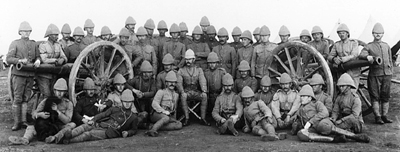Units
Brigade Division, Royal Canadian Field Artillery

The brigade division of artillery in Canada's second contingent grouped together three batteries. Each battery consisted of three sections, each of two 12-pounder breech-loading guns. The 12-pounders, however, were outranged by the Boers' field guns. Despite this handicap, the Canadian gunners more than held their own during operations in South Africa.
The batteries were designated "C", "D", and "E", to signal the brigade division's link to the Permanent Force's "A" and "B" Batteries, Royal Canadian Field Artillery. There was, in fact, a core of permanent force artillery personnel in each battery. Additional members came from militia field batteries. "C" and "D" Batteries' militia gunners came from units in Ontario, and also from Winnipeg; "E" Battery's came from units in Quebec, New Brunswick, and Nova Scotia.
"D" and "E" Batteries arrived in Cape Town in February 1900 and participated in the suppression of the Boer rebellion in the western Cape Colony. "C" Battery, on its arrival in March 1900, went north to Rhodesia to join the Rhodesian Field Force, which then moved south to the relief of besieged Mafeking. The three batteries then continued to operate separately; even sections within each battery often acted independently with different forces, in some cases being detached for months at a time. The brigade division was only reunited at the end of its tour of duty and return to Canada.
Although usually out of the limelight, the three batteries saw much action. A section of "D" Battery particularly distinguished itself at the battle of Leliefontein.
